Analytical study on behaviour of RCC Solid Wall panel and RCC Central opening Wall panel when subjected to Uniformly distributed loading
Y. Sriram pawan kumar1 , Dr. S. Arul Selvan2 , G.Ramesh Kumar31PG Scholar, Department of Civil Engineering, Coimbatore Institute of Technology, Tamilnadu, India
2Associate Professor, Department of Civil Engineering, Coimbatore Institute of Technology, Tamilnadu, India

3Assistant Professor, Department of Civil Engineering, Dr. N.G.P. Institute of Technology, Coimbatore,Tamilnadu
HHTVCCCFFFTTamilnadTamilnadTTamil Nadu, India Tamil Nadu, India ***
Abstract
ThisanalyticalstudyinvestigatesthebehaviorofReinforced Concrete(RCC)solidwallpanelsandRCCwallpanelswith central openings under Uniformly distribute loading conditions. The study is done using ETABS software, to simulate the response of these structural elements and analyzetheirperformanceintermsofloaddeflectioncurve, stresscontour.
Thecentral objective revolvesaroundcomprehendingthe dynamic characteristics of both solid and perforated wall panels in the context of Uniformly distributed loading scenariosthatemulatereal-worldseismicoccurrencesand other dynamic forces. The study further incorporates systematic variations in opening and their impact on the structuralresponse.
Additionally,thestudyhighlightsthesignificanceofstress contoursincomprehendingthebehaviorofthesewallpanels under Uniformly distributed loading. Contours provide a visualrepresentationofstressdistributionacrossthepanels. Using ETABS software, this study shows the advanced computational toolsinpredictingandvisualizing complex structuralresponses,
The outcomesofthisstudy holdpractical implicationsfor structuralengineersanddesigners,providingthebehavior of RCC wall panels under Uniformly distributed loading. Furthermore,theemphasisonstresscontoursemphasizes theirroleininterpretingstressdistribution,enablingperfect decision-makingduringthedesignandassessmentphasesof structuralprojects
Keywords: RCSolidwallpanel,RCWallPanelwithCentral Opening,UltimateLoad,loaddeflection,StressContour,Etabs
1. INTRODUCTION
In structural engineering, understanding the behavior of reinforced concrete (RCC) wall panels under dynamic loadingconditionsisofparamountimportancetoensurethe safety and resilience of built structures. As the modern constructionevolvestoaddressverydifferentarchitectural andfunctional requirements,theperformanceofdifferent
wall panels configurations becomes a critical focal point. This analytical study begins on a comprehensive investigationintothebehavioroftwodistincttypesofRCC wall panels solid panels and panels featuring central opening,underUniformlydistributedloading.
Underpinning this research isthe application of advanced computational tools, with a primary emphasis on the utilization of the finite element analysis ETABS software This tool serves as the means to intricately simulate and analyzetheperformanceoftheRCCwallpanels.Bytesting thesepanelsunderUniformlydistributedloading,thestudy aims to unravel essential facets, including deformation characteristics, stress propagation, and response of the structuralsystems.
Inconclusion,thisresearchmakesanexactcontributionto the existing knowledge in the field, offering practitioners invaluableinsightsintothedynamicresponsesofRCCwall panels when subjected to Uniformly distributed loading conditions.
2. OBJECTIVES
The main objective of this analysis is to compare both RC Solid wall panel and RC Wall panel with Central Openingwhenloadisgivenaxiallyonthe wallpanel.
To compare the two-wall panel performance in termsofload-carryingcapacity,displacementand howthestressisdistribution
Analysis will be performed using finite element softwareE-tabs.
3 LITERATURE REVIEW
R.K.L. Su, S.M. Wong (2016) conducted an experimental study on three reinforced concrete (RC) wall panel specimenstostudytheeffectsofaxialload Thewallsinthe formofaslenderverticalcantilever,fabricatedwithHSCand HLR, were tested. The effects of ALR and confinement on failure, ductility, strength degradation, and axial load capacitywerecriticallyexamined
N. Ganesan 1, P.V. Indira (2013) Here wall panels were castedwithOrdinaryPortlandCement(OPC)andwastested UDL axial load in one-way plane action. This method was proposedtoforecasttheultimateloadofOPC
Junfeng Cheng 1, Xiaoyong Luo 1,2 et al (2022) Herethe pseudo-staticloadinghasbeenconductedonthespecimens toinvestigatetheaxialcompressionratio.Analysiswasalso conductedtoknowtheloaddeflectionbehaviour,cracking patternandstressdistribution.
4. FINITE ELEMENT MODELLING

4.1
An RC Solid wall panel and RC Wall panel with central OpeningisanalyzedusingE-tabssoftwareandbothpanelsof sizesare905*100*980mmandcentralopeningofsizeofone panelis410*456mm.
4.2
HerethepanelsaresubjectedtoUniformlydistributedload ofaxiallyloadedandthesetwopanelswereevaluatedunder Uniformly distributed loading. These panels are placed 400mmabovethegroundlevelfortestingprocess.
4.3
The wall panel cross section is 905mm width, 100mm thickness,980mmheight.M20gradeofconcreteandFe415 steel is used for all wall panels and 25mm of cover is providedallsides.10mmdiameterofbarswereprovidedto allwallpanels,andaspacingof160mmatshorterdirection and175mmspacinginlongerdirection.
4.4
The Young’s modulus of concrete defined was 22360.68 N//mm2,Poissonratiowas0.2.Modulusofelasticityofsteel was200000N/mm2&Poissonratiowas0.3.
4.5
Fig-2: RC Wall panel with Central opening
4.6 Analysis using E-tabs
Here both RC Wall panels are analyzed in E-tabs softwareandUniformlydistributedaxialloadingis appliedonthewallpanel.
AfteranalyzinginE-tabssoftwareultimateloading capacity,load-deflectionbehaviour,stresscontour behaviourisnoted.
ThisistheelevationviewofRCSolidwallpanelin which the supports are in simply supported condition
Fig-3: 3d rendered view of RC Solid wall panel
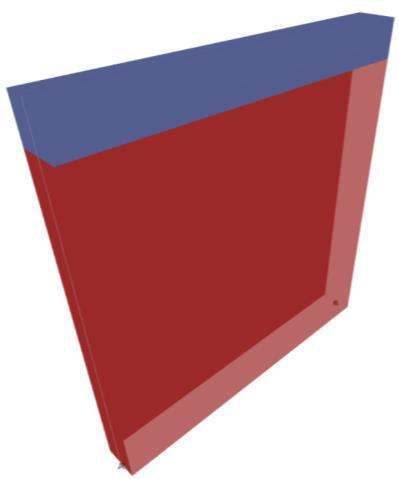
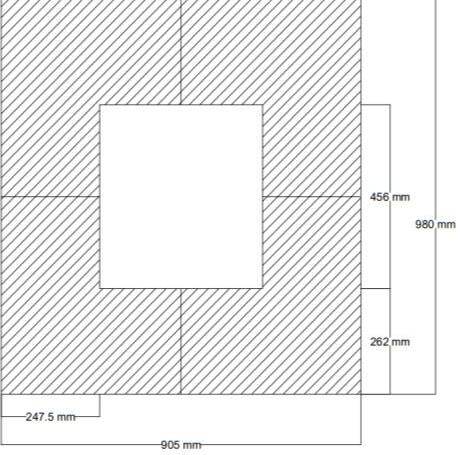
Here RC Wall panel with Central Opening is also testedandthebothwallpanelsarecomparedand windowopeningsizeisgivenas410*456mm
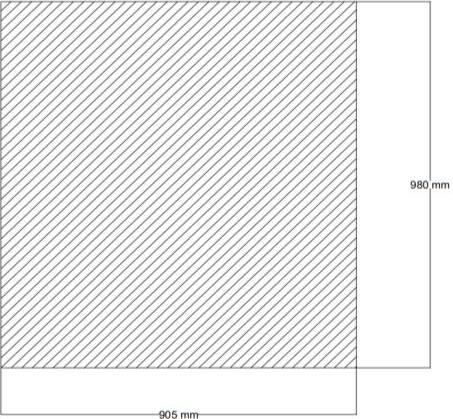
Inthisexperimentuniformlydistributedloadingis appliedaxiallytothewallpanelandloaddeflection, stressbehaviourisstudied.
Loading of 825kN is applied on the RC Solid wall panel.
5.
Storey displacement is studied is RC Solid wall panel.

Maximum of 38mm storey displacement is noted. Starting from 0 it increases gradually to 38mm linearly.
Storeydisplacementgraphisshowninfig7.

Loading of 720kN is applied on the RC central openingwallpanel
StoreydisplacementisstudiedisRCcentralopening wallpanel.
Maximumof100mmstoreydisplacementisnoted. Starting from 0 it increases gradually to 100mm linearly.
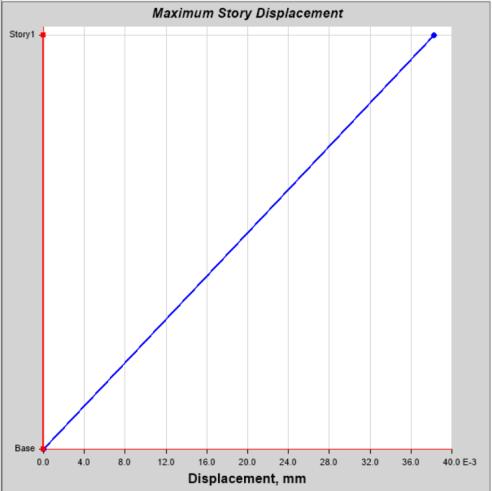
Storeydisplacementgraphisshowninfig8.
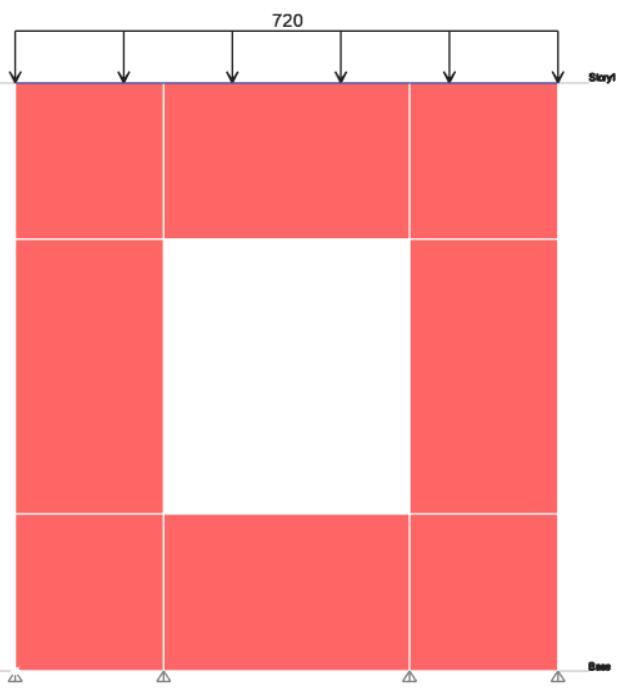
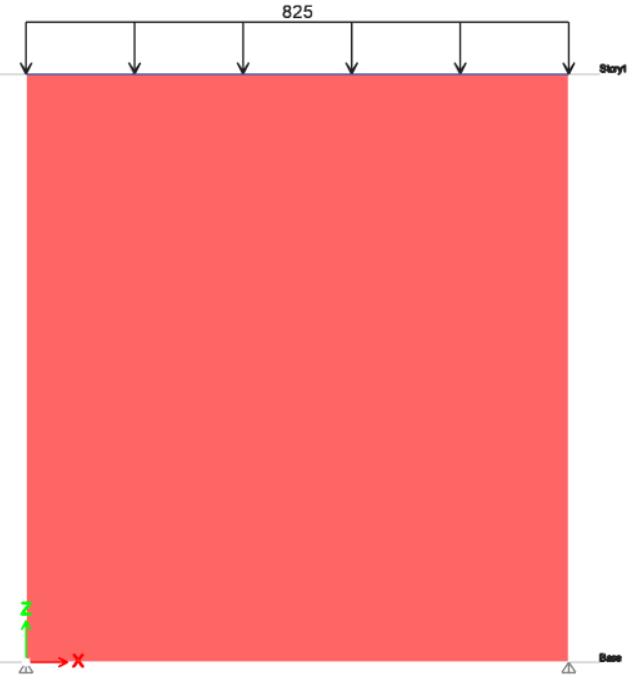
A stress contour is a visual representation in engineeringthatdisplaysthedistributionofstress levelsoverasurfaceorwithinastructure.
Itemployscontourcolorgradientstodepictvarying stress magnitudes, and each contour line representingaspecificstressvalue.
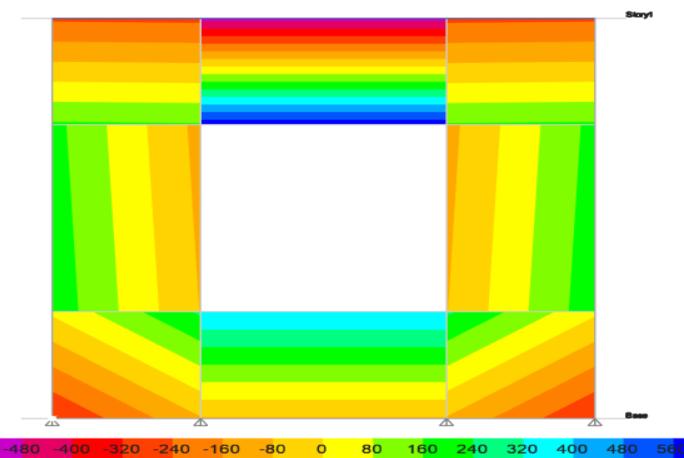
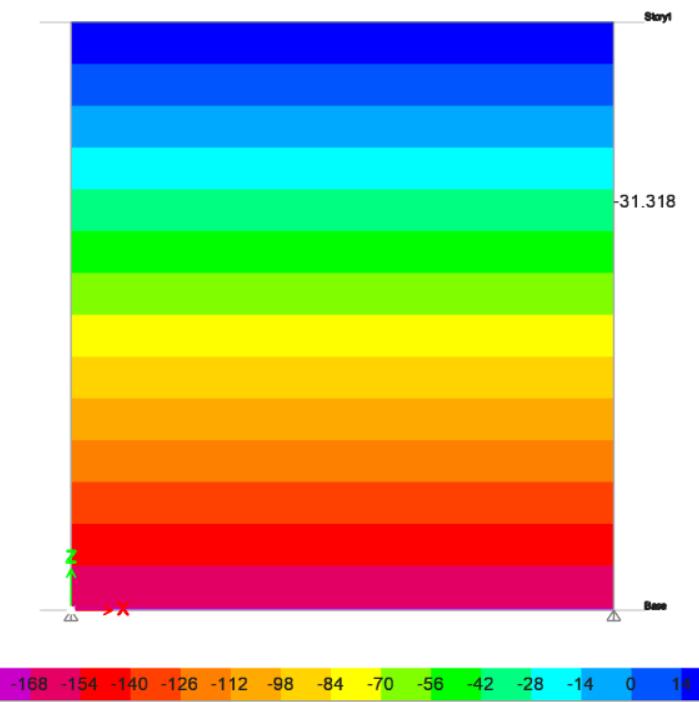
Stress contour enables engineers to identify the regionswherethestressconcentrationismore,and criticalareaswillbehighlighted,andwecanknow how wall panels respond to external loading conditions.
6. CONCLUSION
InconclusionRCSolidwallpanelsustainsmoreloadwhen compared to RC central opening wall panel and due to centralopeningofwallpaneldiagonalshearfailureoccurred andinRCSolidwallpanelflexuralfailurewasnoted.Dueto accurate cover spacing the wall panel sustains more load. Theinteractionbetweensteel andconcretehelpsthewall paneltosustainmoreload.TestingtheseRCWallpanelswe willknowwherethefailureisoccurred,sothatwecangive morestrengthatthatfailureportion.
7. REFERENCE
[1] R.K.L. Su, S.M. Wong, Seismic behaviour of slender reinforcedconcreteshearwallsunderhighaxialloadratio (2006)
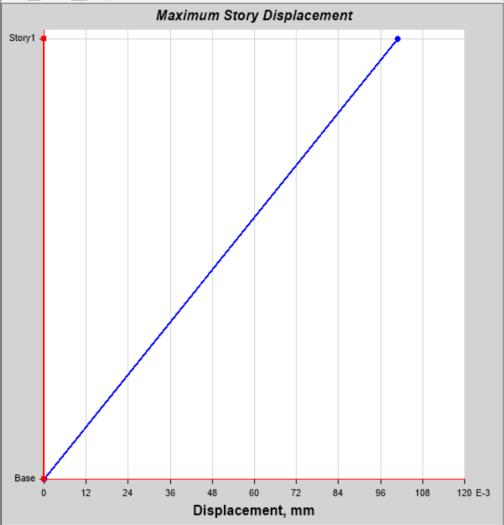
[2]S.Fragomeni,J.H.Doh,etal,BehaviorofAxiallyLoaded ConcreteWallPanelswithOpenings(2011)
[3]C.Todut,D.Dan,Theoreticalandexperimentalstudyon precastreinforcedconcretewallpanelssubjectedtoshear force(2014)
[4]S.Madina,Prakashdesayi,UltimatestrengthofRCwall panelsinone-wayin-planeaction(2015)
[5]MadinaSaheb,andPrakashDesayi,Ultimatestrengthof RCwallpanelswithopenings.(2015)
[6]S.M.Asce,GabrielSasetal,EffectofCut-OutOpeningson theAxialStrengthofConcreteWalls(2016)
[7] G. Prem kumar, V. Thirumurugan et al, An analytical studyonthebehaviourofinfilledRCframewithopeningin infill(2022)

